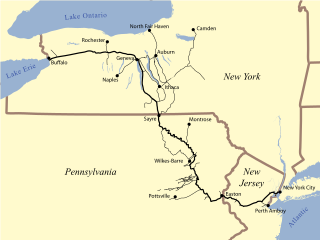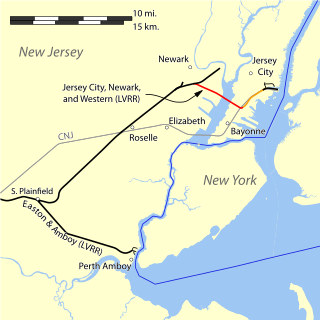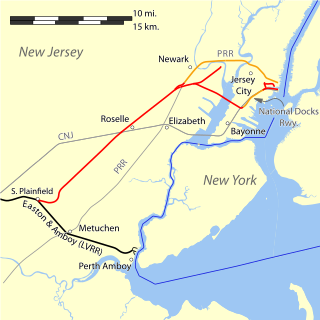
New Jersey Transit Corporation, branded as NJ Transit, and often shortened to NJT, is a state-owned public transportation system that serves the US state of New Jersey, along with portions of New York State and Pennsylvania. It operates bus, light rail, and commuter rail services throughout the state, connecting to major commercial and employment centers both within the state and in the adjacent major cities of New York and Philadelphia.

The Lehigh Valley Railroad was one of a number of railroads built in the northeastern United States primarily to haul anthracite coal. The railroad was authorized on April 21, 1846, for freight and transportation of passengers, goods, wares, merchandise and minerals in the U.S. state of Pennsylvania and the railroad was incorporated/established on September 20, 1847, as the Delaware, Lehigh, Schuylkill and Susquehanna Railroad Company. On January 7, 1853, the railroad's name was changed to Lehigh Valley Railroad. It was sometimes known as the Route of the Black Diamond, named after the anthracite it transported. At the time, anthracite was transported by boat down the Lehigh River; the railroad was meant to be faster transportation. The railroad ended operations in 1976 and merged into Conrail along with several northeastern railroads that same year.

NJ Transit Rail Operations is the rail division of NJ Transit. It operates commuter rail service in New Jersey, with most service centered on transportation to and from New York City, Hoboken, and Newark. NJ Transit also operates rail service in Orange and Rockland counties in New York under contract to Metro-North Railroad. The commuter rail lines had an average weekday ridership of 306,892 from June 1, 2015 to June 30, 2016. This does not include NJ Transit's light rail operations.
Conrail Shared Assets Operations or CSAO is the commonly used name for modern-day Conrail. Conrail is an American railroad company. It operates three networks—the North Jersey, South Jersey/Philadelphia, and Detroit Shared Assets Areas, where it serves as a contract local carrier and switching company for its owners, CSX Transportation and the Norfolk Southern Railway. When most of the former Conrail's track was split between these two railroads, the three shared assets areas were kept separate to avoid giving one railroad an advantage in those areas. The company operates using its own employees and infrastructure, but owns no equipment outside MOW equipment.

For the purposes of this article, the Jersey City area extends North to Edgewater, South to Bayonne and includes Kearny Junction and Harrison but not Newark. Many routes east of Newark are listed here.

The River Line was a Conrail rail line located between Jersey City, New Jersey and Selkirk, New York, running along the west side of the Hudson Palisades and after passing through a tunnel at Haverstraw, New York, along the west bank of the Hudson River. It was previously the New York Central's West Shore Railroad and Weehawken Branch. The River Line has since been split into several sections, following the 1999 division of Conrail assets between Norfolk Southern Railway and CSX Transportation.

Conrail's Passaic and Harsimus Line serves freight in northeastern New Jersey, as an alternate to the mainly passenger Northeast Corridor. It takes trains from the Northeast Corridor and Lehigh Line near Newark Liberty International Airport northeast and east into Jersey City, New Jersey, serving as part of CSX's main corridor from upstate New York to the rest of the east coast.
The Morris and Essex Railroad was a railroad across northern New Jersey, later part of the main line of the Delaware, Lackawanna and Western Railroad.

The Conrail Lehigh Line is a railroad line in New Jersey that is part of Conrail Shared Assets Operations under the North Jersey Shared Assets Area division. The line runs from CP Port Reading Junction in Manville to Oak Island Yard in Newark. The line is double-track and signaled through its entire length. The line began operations in 1999 using former existing tracks from Manville to Newark that was once part of the original Lehigh Line which is still in existence and is owned and operated by Norfolk Southern Railway.

Easton and Amboy Railroad was a railroad built across central New Jersey by the Lehigh Valley Railroad (LVRR) in the 1870s. The line was built to connect the Lehigh Valley Railroad coal hauling operations in Pennsylvania with the Port of New York and New Jersey to serve consumer markets in New York metropolitan area. Until it was built, the terminus of the LVRR had been at Phillipsburg, New Jersey on the Delaware River opposite Easton, Pennsylvania. It is now part of Norfolk Southern Railway operations, partially the Lehigh Line

Bergen Hill refers to the lower Hudson Palisades in New Jersey, United States, where they emerge on Bergen Neck, which in turn is the peninsula between the Hackensack and Hudson River, and their bays. In Hudson County, it reaches a height of 260 feet.

Weehawken Terminal was the waterfront intermodal terminal on the North River in Weehawken, New Jersey for the New York Central Railroad's West Shore Railroad division, whose route travelled along the west shore of the Hudson River. It opened in 1884 and closed in 1959. The complex contained five ferry slips, sixteen passenger train tracks, car float facilities, and extensive yards. The facility was also used by the New York, Ontario and Western Railway. The terminal was one of five passenger railroad terminals that lined the Hudson Waterfront during the 19th and 20th centuries, the others were located at Hoboken, Pavonia, Exchange Place and Communipaw, with Hoboken being the only one still in use.

The Jersey City, Newark and Western Railway was incorporated on July 6, 1889 and acquired by the Lehigh Valley Railroad (LVRR). Construction was completed in 1893. It started in Jersey City, New Jersey at a connection with the National Docks Railway in Communipaw east of the Central Railroad of New Jersey line, and extended westward on the bridge across Newark Bay to connect with the LVRR's Newark and Passaic Railway.

The Lehigh Valley Terminal Railway was a Lehigh Valley Railroad company organized in 1891 through the consolidation of the companies that formed the Lehigh Valley's route from South Plainfield through Newark to Jersey City via its bridge across Newark Bay. Until 1895, when the Greenville and Hudson Railway was constructed, the Lehigh Valley depended on the National Docks Railway to reach the Hudson River terminal.

The Upper Bay Bridge, or the Lehigh Valley Railroad Bridge, is a vertical lift bridge spanning the Newark Bay in northeastern New Jersey. It is used by CSX Transportation travelling through the North Jersey Shared Assets Area of the United States rail network along the National Docks Secondary line. The bridge is just north and parallel to the New Jersey Turnpike's Newark Bay Bridge. A notable train using the bridge is the Juice Train, which originates in Florida.

Oak Island Yard is a freight rail yard located north of Port Newark-Elizabeth Marine Terminal and Newark International Airport in an industrial area of Ironbound, Newark, New Jersey at 91 Bay Ave., United States. The sprawling complex includes engine house, classification yard, auto unloading terminal, and maintenance facilities. It has ten reception tracks, an automated hump, 30 relatively short classification tracks, and nine departure tracks. In 1999, it classified 800 to 1000 cars per day.
The North Bergen Yard is freight rail yard and intermodal terminal in North Bergen, New Jersey parallel to Tonnelle Avenue between 49th and 69th Streets. Located within the North Jersey Shared Assets Area, the facility is part of CSX Transportation (CSXT) and the origination point of its CSX River Subdivision at the southern end of the Albany Division. On its west side, the New York, Susquehanna and Western Railway (NYSW) runs the length of the yard and operates a bulk transloading operation immediately adjacent to it.

The Lehigh Line is a railroad line in central New Jersey and northeastern Pennsylvania. It is owned and operated by the Norfolk Southern Railway. The line runs west from the vicinity of the Port of New York and New Jersey to the Susquehanna River valley at the south end of the Wyoming Valley Coal Region. Administratively it is part of Norfolk Southern's Harrisburg Division and is also part of the Crescent Corridor. As of 2016 the line is freight-only, although there are perennial proposals to restore passenger service over all or part of the line.



















